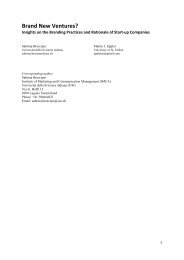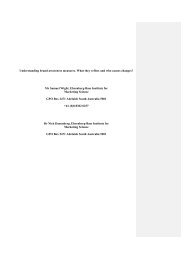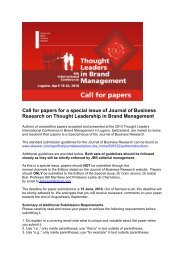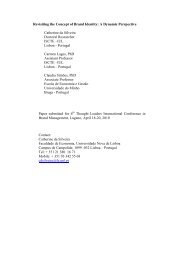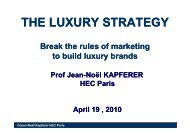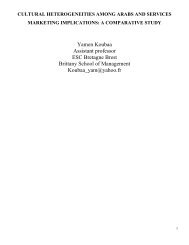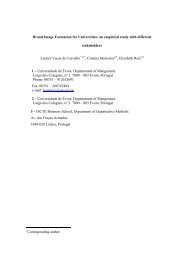Esch, Franz-Rudolf, Winter, Kai, Limited Editions
Esch, Franz-Rudolf, Winter, Kai, Limited Editions
Esch, Franz-Rudolf, Winter, Kai, Limited Editions
You also want an ePaper? Increase the reach of your titles
YUMPU automatically turns print PDFs into web optimized ePapers that Google loves.
6Hypothesis 6: The launch of a limited edition under a weak brand has a positive effect on thebrand’s attitude. In case of a strong brand, the attitude towards the brand remains the same.Hypothesis 7: The introduction of a limited edition has a positive effect on the perceivedcreativity of the brand, regardless of the strength of the brand.RESULTSFor the verification of the hypotheses, three experiments were carried out. An evaluationtakes place through analyses of variance.Experiment I: The aim of the first experiment was to examine in what way the effect ofproduct limitation, which is characteristic for limited editions, is dependent on the explorationtendency of the consumers. The design of the study is a 2x2-factorial between-subject-design.On the one hand, the limitation has been varied as one factor (with vs. without indication oflimitation). An illustration of the product line of the fictitious frozen pizza brand Osseo waspresented to the test persons with the test product “Mozzarella-Rocket-Parma ham” as well asthe two standard varieties (“Margherita” and “Salami”). In comparison with the experimentalsituation “no limitation”, in the situation “with limitation” additional information “<strong>Limited</strong>Edition – Only for a Short Time” were provided to the product “Mozzarella-Rocket-Parmaham“ (see appendix). On the other hand, a division of the examination participants accordingto their exploration tendency took ex post place (high vs. low exploration tendency). Thistendency has been operationalised by using the “Exploratory Acquisition of Products” (EAP)-Index (Baumgartner and Steenkamp 1996). The differentiation between exploration seekerand exploration avoider is made on the basis of a median split (Menon and Kahn, 1995). Intotal, 120 students of a German university were interviewed. For the dependent variable, theperceived novelty of the product, the attitude towards the product as well as the trial interestwere captured on the basis of nine-level bipolar items (see appendix). In addition, the productinvolvement for frozen pizza was included as a possible disturbance variable. Results ofexperiment I: Through the signalling of the limited availability, the altogether perceivednovelty of the test product increases to a significant extent (F 1.116 =5.694, p



